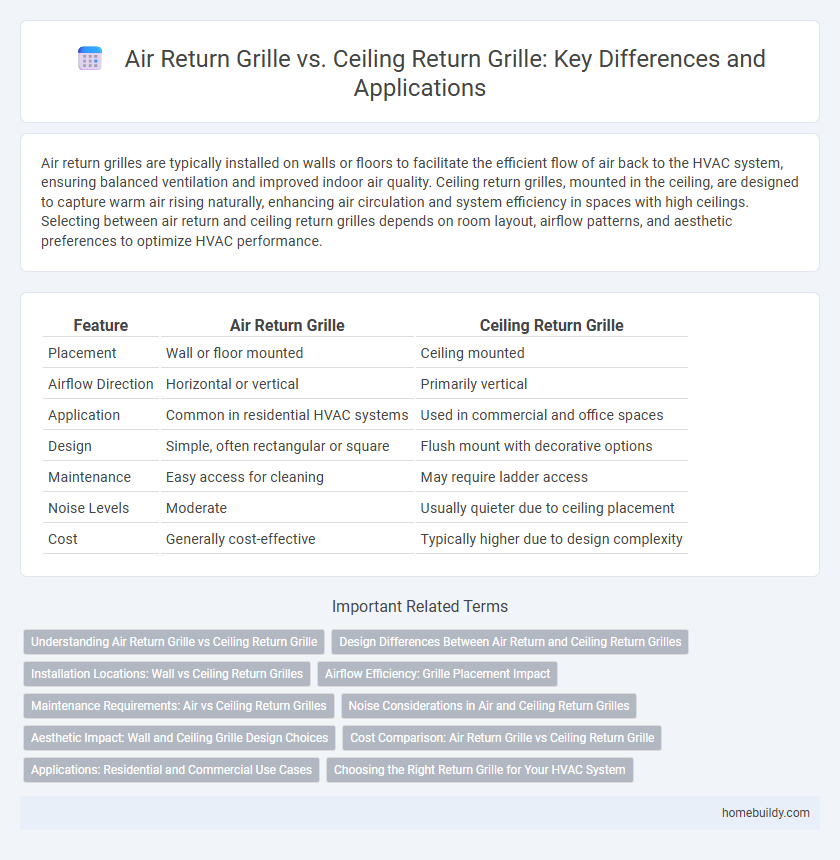Air return grilles are typically installed on walls or floors to facilitate the efficient flow of air back to the HVAC system, ensuring balanced ventilation and improved indoor air quality. Ceiling return grilles, mounted in the ceiling, are designed to capture warm air rising naturally, enhancing air circulation and system efficiency in spaces with high ceilings. Selecting between air return and ceiling return grilles depends on room layout, airflow patterns, and aesthetic preferences to optimize HVAC performance.
Table of Comparison
| Feature | Air Return Grille | Ceiling Return Grille |
|---|---|---|
| Placement | Wall or floor mounted | Ceiling mounted |
| Airflow Direction | Horizontal or vertical | Primarily vertical |
| Application | Common in residential HVAC systems | Used in commercial and office spaces |
| Design | Simple, often rectangular or square | Flush mount with decorative options |
| Maintenance | Easy access for cleaning | May require ladder access |
| Noise Levels | Moderate | Usually quieter due to ceiling placement |
| Cost | Generally cost-effective | Typically higher due to design complexity |
Understanding Air Return Grille vs Ceiling Return Grille
Air return grilles primarily serve to draw air back into the HVAC system through wall or floor-mounted openings, facilitating efficient airflow and filtration. Ceiling return grilles are installed in ceiling spaces, often integrating with suspended ceilings, and are designed to capture returning air at higher elevations. Understanding the distinction helps optimize ventilation system placement, ensuring balanced air circulation and improved indoor air quality.
Design Differences Between Air Return and Ceiling Return Grilles
Air return grilles typically feature a low-profile design with louvers angled to efficiently capture air from walls or floors, optimizing airflow distribution and minimizing noise. Ceiling return grilles often have a flatter face with larger open areas or perforations that facilitate higher volume air return from ceiling spaces without obstructing lighting fixtures. The distinct structural elements in each grille type adapt to their installation location, enhancing both system performance and interior aesthetics.
Installation Locations: Wall vs Ceiling Return Grilles
Air return grilles installed in walls are ideal for residential spaces where unobtrusive airflow is necessary, typically placed near the floor or ceiling to promote efficient air circulation. Ceiling return grilles, commonly used in commercial buildings and larger areas, are positioned in ceilings to facilitate the removal of warm air rising naturally, enhancing HVAC system performance. The choice between wall and ceiling return grilles depends on architectural design, room function, and airflow requirements to ensure optimal indoor air quality and energy efficiency.
Airflow Efficiency: Grille Placement Impact
Air return grilles typically enhance airflow efficiency by being positioned lower on walls, allowing warmer air to be effectively drawn back into HVAC systems, while ceiling return grilles pull air from higher elevations, which can lead to uneven room temperature. Placement of air return grilles near the floor promotes better circulation and reduces pressure imbalances, optimizing system performance. Ceiling return grilles may cause stratification, reducing overall airflow effectiveness compared to strategically placed air return grilles.
Maintenance Requirements: Air vs Ceiling Return Grilles
Air return grilles typically require more frequent cleaning due to their placement in walls or lower areas where dust accumulation is higher, compared to ceiling return grilles that benefit from natural gravity to reduce debris buildup. Ceiling return grilles often need less maintenance but can be harder to reach, necessitating specialized equipment for thorough cleaning. Proper upkeep of both grille types ensures optimal airflow and energy efficiency in HVAC systems.
Noise Considerations in Air and Ceiling Return Grilles
Air return grilles typically generate less noise compared to ceiling return grilles due to their larger surface area and placement, which allows smoother air velocity and reduced turbulence. Ceiling return grilles often produce higher noise levels because of confined ductwork and restricted airflow, leading to increased vibration and acoustic disturbances. Proper selection and installation of air return grilles minimize HVAC noise, enhancing indoor air quality and occupant comfort.
Aesthetic Impact: Wall and Ceiling Grille Design Choices
Air return grilles and ceiling return grilles differ significantly in aesthetic impact, with wall grilles often providing a more subtle, streamlined appearance that can blend seamlessly with interior decor. Ceiling return grilles tend to be more conspicuous due to their placement but offer uniform airflow distribution, making them a functional choice for modern spaces seeking minimal visual disruption. Selecting between wall and ceiling return grilles depends on balancing airflow efficiency with the desired visual integration in the room's overall design.
Cost Comparison: Air Return Grille vs Ceiling Return Grille
Air return grilles generally have a lower installation and maintenance cost compared to ceiling return grilles due to simpler mounting requirements and easier accessibility. Ceiling return grilles often involve higher expenses because of the need for structural adjustments and specialized labor during installation. Cost efficiency tends to favor air return grilles, especially in retrofit projects and residential applications.
Applications: Residential and Commercial Use Cases
Air return grilles are commonly used in residential HVAC systems to facilitate efficient airflow from living spaces back to the air handler, ensuring consistent temperature regulation and improved indoor air quality. Ceiling return grilles, preferred in commercial settings, offer higher airflow capacity and seamless integration with suspended ceilings, making them ideal for large office buildings, retail stores, and hospitals. Both types enhance system performance but are selected based on installation environment, airflow requirements, and aesthetic considerations specific to residential or commercial applications.
Choosing the Right Return Grille for Your HVAC System
Air return grilles are typically wall-mounted and designed to efficiently draw air back into the HVAC system, providing optimal airflow and filtration. Ceiling return grilles, installed flush with ceiling surfaces, offer a discreet option that suits spaces with limited wall area while maintaining effective air circulation. Selecting the right return grille depends on room layout, airflow requirements, and aesthetic preferences to ensure balanced ventilation and improved energy efficiency.
Air return grille vs Ceiling return grille Infographic

 homebuildy.com
homebuildy.com